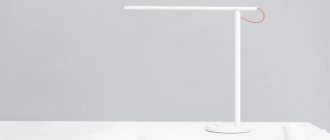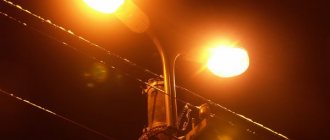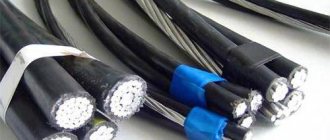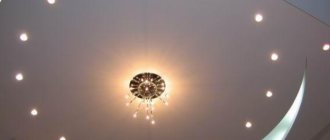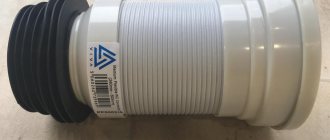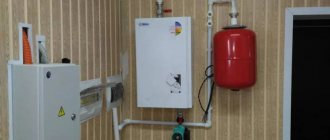Light lines on a stretch ceiling look original and transform the surface. There are different options for implementing this solution, so it’s worth understanding them to choose the right one. It can be used both for decoration and as main lighting if the line width is large and there are enough light sources installed inside.
Light lines are an original solution for a stretch ceiling.
What are linear LED luminaires?
These lamps represent a class of LED lamps, which today have almost replaced incandescent light bulbs from everyday use and have noticeably pushed aside their main competitors - fluorescent lamps. Their feature is a strict design that allows them to fit into any interior.
Linear LED luminaires are long single lamps. They have an elongated body in the shape of a parallelepiped. This simple device has already found wide application in everyday life and production. They are used to illuminate buildings, premises, and workplaces in offices, classrooms, and kitchens.
LED lines are especially in demand in:
- educational institutions;
- libraries;
- restaurants;
- gyms;
- garages;
- hotels;
- shops and shopping centers;
- swimming pools.
Linear luminaires differ from each other in design and other parameters. By selecting the necessary models, they organize different lighting options - they illuminate the entire room, a separate zone and a certain element of the interior.
Bottom line
As a result, this type of lamps is extremely popular for a reason - users from all over the world create their own interior design using clever shapes and designs, use light in a variety of ways and show their room more interestingly, more harmoniously. If you also want to realize your ideas, then you should take a closer look at linear lamps.
Advantages and disadvantages
Linear LED lamps are an innovation in the light organization system. Their widespread use is limited only by the lack of consumer awareness about the enormous advantages of such lamps.
Pros:
- Versatility. Suitable for implementing various tasks and ideas.
- Shadowless lighting. Any point lighting device, including chandeliers, creates light spots. Linear models illuminate the room evenly without leaving shadows.
- Safety. Does not contain toxic substances (mercury). Safe for humans and the environment. They can be thrown away with regular trash.
- Modularity. Many lamps are created in the form of modules. They are assembled in a certain way, achieving the desired light accents.
- High quality lighting. It is smooth and moderately contrasting, maximally safe for the human vision and nervous system. Doesn't heat up or flicker.
- Reliability . The housing and all other structural elements are vibration-resistant.
- Comfortable inclusion. No time is wasted on ignition. The lamp lights up instantly, immediately reaching the set brightness.
- Duration of service. It is an order of magnitude longer than the operating time of incandescent lamps. Estimated service life is 12 years or 50,000-100,000 hours (depending on the manufacturer).
- Saving. It features low energy consumption, allowing you to save on electricity bills. Linear LED lamps reduce energy consumption by 80-90% compared to conventional incandescent lamps.
- Correct visualization of objects. Achieved due to excellent color transmission and high brightness (120 Lm/W).
- Low heat c. LED lines emit little heat, which allows them to be used in combination with lining and suspended ceilings.
- Selecting the lighting temperature. Users can choose from three options – warm, neutral and cool light.
Thanks to the design features of the housing, linear luminaires are resistant to almost all negative factors - temperature changes, moisture, mechanical stress.
LED lines do not require adapters; they are connected directly to the 220 V network.
Disadvantages of a linear lamp:
- May fail due to voltage surges. The built-in power supply does not save the device during significant surges. It is recommended to use additional protection blocks.
- If the power supply fails, you have to replace the entire device, since it is a single mechanism filled with electronics.
- Needs heat dissipation. The substrate to which the LEDs are attached is responsible for it. If the fastenings are broken, cavities may form that prevent normal heat dissipation, which leads to damage to the device.
Types of linear lighting
The use of lightweight and reliable LED panels allows you to place the lamps almost anywhere and anywhere. They can be installed on any surface, provided that the light flux is directed perpendicular to the main axis of the room.
LED panels provide four main lighting schemes:
- Ceiling option. The lamp is placed either on the ceiling plane or mounted in its structure. This scheme is most in demand for residential premises;
- Hanging option. Mainly used for rooms with high ceilings. Lamps on ceiling suspensions are used in offices, conference rooms, spacious halls and even in workshops as the main source of light located above the table or above the place where a large number of people work;
- Mobile and rotating lamps are often used as additional lighting. In some cases, the design allows you to adjust the direction of the light flux;
- Floor and wall layouts. This type is used mainly for small rooms, including those with low ceilings or complex interior design.
Lamps with wall or floor mounting are used mainly in small compact rooms, often with a complex ceiling design. Sometimes a wall lamp is an element of interior design in a cafe or entertainment venue.
Suspended lighting option
Linear light in architectural lighting of buildings
An LED lamp can provide a fairly powerful and bright stream of light, which is why such devices are used to illuminate facades and decorative elements of modern buildings.
Structurally, such models differ from a regular home lantern in two parameters:
- The case is made in a waterproof design;
- LEDs are installed in reflector cups with lens attachments.
Illumination of walls and facades with LED lights
The result is a relatively uniform luminous flux, which is clearly visible even in the evening. The power of architectural lamps is approximately 2-5 times higher than in household models. The devices themselves can be mounted either directly on the wall cornices or mounted on brackets.
Linear lights can be used without restrictions as street spotlights for emergency lighting in private households.
Outdoor LED floodlight
One of the most popular models is the linear panel-spotlight SD-XX.
The case is protected according to the IP67 standard, while the device can operate in a very wide temperature range, consumes only 20-70 W, producing a light flux at the level of a kilowatt flashlight.
Linear LED lights for home
For domestic needs, relatively short lanterns are most often used. Placing long lamps on the ceiling in a small room is extremely inconvenient, so the maximum size rarely exceeds the standard of 120 cm. At the same time, the electricity consumption of an LED panel is in the range of 10-22 W.
LED StickT5
For example, the well-known linear LED lamp LED Stick is manufactured in the form of an aluminum box with a polycarbonate lid. The dimensions of the device are 1176x22x34 mm, which is the best option for the home.
Ceiling linear LED luminaires
Moving lighting fixtures to the ceiling is the most optimal option for building lighting in an apartment. Both the above-mentioned LED Stick and the cheaper HX-20, shown in the photo below, are suitable for these purposes.
If the LED Stick produces a luminous flux with a temperature of 4700K, then the HX-20 matrix, like the main part of the ceiling lamps, generates light with a temperature of 5600-6400K.
Important! The cheaper linear lamps, the harsher the light.
A standard linear lantern for a home is usually a plastic panel covered with a polycarbonate cap. The housing is manufactured to IP20 protection class. This means that the lighting system will need to be protected from dust and moisture by additional means.
Pendant linear LED luminaires
The above devices are installed on the ceiling by inserting into the surface or fixing on brackets. If the ceiling height of the room is high enough, then built-in structures are not so effective. Therefore, the housings have to be mounted on special wire hangers or on tubular rods. Pendant linear luminaires differ from conventional ones only in the installation method.
An example of such a design would be a linear-type pendant lantern, shown in the photo below.
The body is usually made of aluminum or plastic, in white or matte black. The power of such a device usually does not exceed 30 W, the length of the body is maximum 120-130 cm. When installed correctly, one such lamp is enough to illuminate a room with an area of 10-12 m2.
Recessed LED linear luminaires
A completely new class of lighting devices. Appeared simultaneously with the widespread use of stretch and suspended ceilings. For vinyl ceiling structures, linear lights are used that are built into the ceiling frame elements. In this case, it is possible to hide the structure behind PVC decor, or simply make them unnoticeable.
Recessed linear lighting
In modern design, recessed linear lamps are often used as a decorative element; the technology allows you to assemble entire compositions from luminous broken lines and arrows.
Wall linear LED luminaires
A close relative of the ceiling lighting fixture can be considered a wall structure. The main difference is that the body is installed on a vertical surface, so the main flow of light is directed either towards the wall or down.
A linear wall lamp is inferior to ceiling lamps in terms of lighting efficiency, but is noticeably superior to it in ease of maintenance. Typically, wall-mounted emergency lanterns are equipped with a built-in battery.
Convenient maintenance has made wall lights quite popular for installation in the kitchen. Energy consumption is lower; moreover, it is always easier to remove a decorative cap from the wall than from the ceiling.
Rotating linear diode luminaires
More modern designs of lighting devices are made with articulated supports, which allows you to change the direction of the light flow. This could be a wall-mounted linear LED lantern, as in the photo.
Universal turning light
Or an outdoor version of the SPS LED spotlight.
Overhead long LED lamps
Most of the home linear lights based on LED matrices are manufactured in the form factor of an overhead housing. This means that you don’t need to think too much about where and how to embed the device into the ceiling trim, but simply choose the most suitable place to install the linear light and secure it.
Universal housing option
Many of the surface-mounted lamps have a universal body type, which allows them to be used simultaneously for wall and ceiling installation without modification.
Ceiling models
As a rule, a surface-mounted linear lantern is available in two housing options:
- Elongated square panel. The light flux is directed through the lower plane, covered with a transparent cover;
- The circuit has a flat base, and the LED matrix is covered with a semicircular polycarbonate cover.
Surface-mounted LED models are considered the easiest to repair, maintain and replace.
Touch linear luminaires
Turning lights on and off is usually done using conventional two-position switches. The button is convenient, but not entirely aesthetically pleasing. In the new wall-mounted and surface-mounted linear LED lights, the switch is touch-sensitive. The transparent cover has a built-in optical sensor that responds to touch.
The sensor design does not stick due to dust and does not break with frequent use.
Design
A linear LED lamp, like other lighting devices, consists of four main parts - a light-emitting element, a power supply and a cooling system, placed in a housing.
Light emitting element
The light source is super bright LEDs. In one device their number reaches tens. The luminous flux and dimensions of the lamp depend on how many diodes are installed on the module.
The sizes of LEDs range from fractions of a millimeter to several centimeters. They are attached to rectangular strips - modules. Instead of diodes, micro-matrices can be used, which contain many unpackaged LEDs - tens and even hundreds.
The use of matrices allows you to significantly increase the luminous flux without increasing the size of the lamp. The matrix, which contains about a hundred mini-diodes, having the size of a regular LED, exceeds it in power several times.
power unit
This node is also called the driver. It is a rather complex electronic device and provides the LED module with the required voltage level. LEDs are sensitive and vulnerable semiconductor elements. A small surge in the network is enough for them to fail.
What problems does the LED driver solve:
- Reduces the mains voltage (220 V) to the value required by the matrix.
- Converts alternating voltage to direct voltage. All diode elements, operating on alternating current, conduct only a half-cycle of the signal. This mode of operation is not suitable; it is necessary to power the diodes with direct current.
- Stabilizes the current at the level required for a specific matrix.
- Suppresses impulse noise and high-voltage surges that occur in the network.
Cooling system
There is an opinion that light sources operating on semiconductor elements do not heat up. But if you put your hand on the body of the lamp after it has been running for several minutes, you will be convinced that there is heating. To remove heat, radiators are installed in LED devices.
Heat dissipation elements have a ribbed surface and are made of metal. They are often located outside the device. Modules with diodes are mounted on radiators. If the case is made of metal, the radiator is often not installed, since its role is played by the casing itself.
Keep the outer surfaces of LED lamps clean by wiping off dust at least once a month. Otherwise, the dust layer interferes with the cooling of the LEDs, and they may burn out.
Frame
The mechanical strength of the device and the duration of its operation depend on the quality of this element. The body consists of two parts - the casing and the diffuser glass. For recessed luminaires, the body is hidden, so there are no special requirements for it.
For surface-mounted lamps, the body must match the interior of the room. Glass – white or transparent, polycarbonate or regular. The casing is made of metal or plastic. The best option is aluminum; it dissipates heat well, preventing the module from overheating.
Plastic cases have different designs. It is recommended to pay attention to the following points:
- there should be no backlash (free space between parts);
- the presence of even holes in the required quantity.
Rating of the best suspended structures
Mantra 5530
The products are manufactured by a Spanish company. Degree of protection – IP20. Made in high-tech style. Rectangular lampshade. Chrome fittings. The lampshade is transparent. Horns are not provided. Durable glass is used to make the lampshade. Dimensions – 120*1200*1600 mm. Height adjustment is provided. Lamps with a power of 36 W. Voltage - 220 V. The base is a built-in LED. Fills the room with daylight. There is no control panel, as well as the ability to dim. The maximum possible coverage area is 12 sq.m. A cable is used as a suspension. Fastening is carried out on the mounting plate. The mounting location is the ceiling. Package weight – 5.4 kg. The manufacturer provides a guarantee for its creation for five years.
Retailers offer the product at a price of 32,160 rubles.
lamp Mantra 5530
Advantages:
- practicality;
- functionality;
- ease of use;
- value for money.
Flaws:
- not found.
Ideal Lux 138237
Stylish product from an Italian manufacturer. Domestic consumers are attracted by the reliability, attractive appearance and long service life of the structure. The degree of dust and moisture protection is minimal, so installing the device outdoors is not recommended. The appearance is modern. The shape of the lampshade is rectangular. The fittings and lampshade are white, durable, metal. Dimensions – 1025*1200*200 mm. It is possible to adjust the height. Lamp type – LED. The glow is warm and white. There is no control panel provided. Hangs on the ceiling. Illuminates an area up to 8 sq.m. Hangs on a wire. The warranty is valid for one year.
The purchase price is 29,516 rubles.
Ideal Lux lamp 138237
Advantages:
- strength of the material used;
- build quality;
- reliability;
- attractive appearance;
- functionality;
- ease of installation.
Flaws:
- not installed.
Vele Luce VL10142P24
The products are manufactured by an Italian company. The minimum degree of protection indicates that the device is installed only inside a heated and dry room. Made in high-tech style. The rectangular lampshade in an interesting black color is made of metal. The fittings are also metal to match it. Dimensions – 110*1200*1200 mm. Halogen or LED lamps. Power – 35 W, voltage – 220 V. No dimmability. The manufacturer does not provide a remote control. Installed on the ceiling. Lighting area – 6 sq.m. Attaches to mounting plate. Box weight – 3.7 kg.
Purchase price – 20,000 rubles.
lamp Vele Luce VL10142P24
Advantages:
- practicality;
- ease of installation;
- value for money;
- positive reviews;
- two year warranty.
Flaws:
- not identified.
Novotech 358051
Products from a Hungarian manufacturer with a minimum degree of protection. Made in high-tech style. Rectangular shape, black color. The horn is missing. The lampshade and fittings have a matte surface. The lampshade is made of plastic, the fittings are made of durable aluminum. Product parameters – 43*1216*1566 mm. Lamps included. The dispersion angle is 104 degrees. Coverage area – 8.5 sq.m. Installation is carried out on the ceiling.
The average cost is 19,580 rubles.
lamp Novotech 35805
Advantages:
- stylish design;
- practicality;
- functionality;
- ease of installation;
- value for money.
Flaws:
- none.
What types of linear LED lamps are there?
All linear lamps have an elongated, regular shape and glow evenly along their entire length. The angle at which the flow is dissipated depends on the design features and ranges from 100-180 degrees.
According to the method of mounting, lamps are distinguished:
- Angular. These models are placed in niches, corners of rooms, under bedside tables or shelves. They are also used for interior decoration. They visually round corners and expand the space.
- Built-in. They are usually built into the ceiling or walls. The light-emitting glass remains visible to the eye. The lamp practically does not use the free volume of the premises, since it is completely recessed into the surface. It is not possible to integrate the device into all materials. For example, it is problematic to place it in concrete floors.
- Invoices. Such lamps are completely visible. They are attached to walls, ceilings or any other surface. The advantage of such models is simple installation.
- Hanging. They are mounted on hangers, the length of which varies. Thanks to this installation principle, it is possible not only to organize high-quality lighting taking into account the zoning of the room, but also to introduce an interesting detail into the interior.
Depending on the mounting location, models are distinguished:
- ceiling;
- façade;
- wall-mounted
There are models in which the lighting intensity is changed using a switch.
Areas of application
Let's start with the fact that initially linear lamps in the interior were used exclusively as secondary lighting devices. This means that the room already had some main light sources, be it a chandelier, floor lamp, pendant lamp on the ceiling, and so on.
Thanks to the combination of the main light source and an additional one, it became possible to give the room an interesting look, to illuminate certain areas of the room a little better, without losing the good quality of light in the main part of the room.
For a better understanding, in the living room above the sofa and tea table, where you and your friends usually chat and watch TV, or meet with your family, the main light source is installed - a lamp with a powerful 8-9 W bulb, which illuminates the entire room with sufficient least. Or the chandelier is used with several light bulbs, this is not so important.
Thanks to the presence of a main light source, you can easily experiment with secondary light sources and get an interesting picture of the room that cannot be obtained using other devices.
The option with illuminated windows looks very interesting, if we are talking about the living room, plus the table or additional tables with photographs, art objects, or a collection of something are well illuminated. A secondary light source does not have to illuminate the entire room; it will illuminate its area exclusively and, thanks to its bright spot of light, will attract the attention of visitors to the room.
In addition, very often lamps of this type are installed in the corridors of apartments or houses - you get good lighting of the corridor, in which there is usually either no lighting at all, or it is quite weak and does not give you the opportunity to see everything around you in detail.
Installation and connection of linear LED lamps
Lamps used in suspended or suspended ceilings are placed in pre-prepared boxes that do not protrude beyond the structure. This installation gives the effect of diffused lighting.
In kitchens, lamps are often hung on chains or holders. This solution creates a lightness effect that looks harmonious in high-tech and minimalist interiors.
To install the lamp you will need:
- two screwdrivers - flat and Phillips;
- insulation removal tool;
- pliers.
The linear lamp is connected like a regular round LED lamp. To install it:
- Lay live wiring. Be sure to check the quality of its insulation.
- Install the device according to its type. Make sure the lamp is securely fixed.
LED lamp connection diagram:
A video about installing LED linear luminaires is located below:
Profiles for creating light lines in a suspended ceiling
To ensure that the LED lines on the ceiling are perfectly straight and give the desired effect, special profiles are used. There are many options and each has its own characteristics, it is worth considering the most common solutions:
- SP1 – a universal type, which is used both to create a light line and to join different canvases at the same level or in the construction of multi-level systems. Usually this element is attached to the KP2 profile, which is located on the ceiling. The space between the two profiles is covered with a translucent film to diffuse light, and the joint is decorated with an oval insert. In this case, the light line is always recessed into the surface; not everyone likes a small recess.
Combination of two types of profile.
Frame profile KP 2 - SP2 is used much more often, since when installing light strips with its help, the surface is smooth. In this case, the profile is attached in the same way as the previous version. The minimum line width is 20 mm, and the maximum is not limited; you can make an indent that will look best in the room.
- SP5 - a specially designed version to create light lines 18 mm wide. It is attached directly to the ceiling surface, which simplifies work, and the outer part is covered with a special diffuser, which provides uniform lighting.
SP5 profile design - KP4075 has a similar design to the previous solution, but you can install an LED strip in two rows to increase the backlight intensity. The width of the line in this case will be 35 mm, the strip is covered with a translucent film. Many craftsmen use this solution to create oval lines by filing the profile in the right places.
- PK9 is another similar solution, but its width is already 5 cm. It is used for both flat and oval stripes.
- Apply is a ceiling molding that can be used for light lines. The “universal” option has a width of 10 cm, and the “mini” option is 5 cm. Suitable for both lighting and multi-level structures and creating a floating ceiling effect.
Option for installing LED strip in two rows. (KP profile 5)
These are the most common types, there may be other brands, but most often they have a similar design.
Operating rules
Linear LED lamps are considered reliable devices, but for them to work flawlessly, install them correctly and then follow the instructions for use.
Installation and operation:
- Installation and dismantling is carried out with the mains power turned off.
- Linear LED devices are connected to a high-quality electrical network without sudden changes and voltage surges. It is recommended to connect LED modules to 220 V through network adapters that have built-in protection.
- Check electrical connections and wiring integrity regularly. The lamp must not be turned on if it is damaged.
- It is prohibited to operate luminaires that have mechanical damage to the casing or protective glass. Before installation, check the integrity of the housing.
How to replace a light bulb in a burnt-out lamp?
Modern models do not have any light bulbs. Everything in them is usually assembled using LEDs.
It used to be that powerful halogen lamps were installed there.
Therefore, if your track lamp burns out, you will most likely have to change it entirely.
There are models with one large LED.
And there are many small SMDs (bad option).
You can even try to repair these yourself. Based on the principle of repairing a burnt out LED light bulb.
The positive point is that if you bought the track system not on Ali, but in a company store, then they usually have a 5-year warranty.
And in case of any problems, the lamp is replaced with another one free of charge. If possible, choose lamps with a lens inside rather than a reflector.
The lens provides more comfortable and high-quality lighting. In addition, by installing a different lens, you can get a different dispersion angle. And all this without replacing the LED itself.
How to choose an LED lamp?
When choosing linear LED lamps, be guided by their technical characteristics. The parameters of LED devices differ significantly from those of incandescent lamps, so they are not understandable to an untrained user.
Manufacturer
Today you can find lamps on sale from domestic, Chinese and Western manufacturers. The latter are more expensive, but promise greater quality.
When buying such a high-tech item as LED lamps, it is useful to first familiarize yourself with the manufacturing company.
Voltage
The supply voltage is usually specified as a range within which the manufacturer guarantees uninterrupted operation of the device. If the device says “from 176 to 264 V,” this means that it can cope with almost any changes when connected to a 220 V network, and does not lose brightness.
The wide range of input voltages is due to the presence of a driver. LED lamps can be powered from AC/DC 220 V/12 V.
Power
The power of LED lamps and luminaires is an order of magnitude lower than that of other types of lighting devices. There is a comparison table on the package from which the user can determine what incandescent lamp power the LED lamp corresponds to.
There are linear lamps on sale with a variety of powers: 4, 6, 8, 16, 18, etc. For example, an 8 W LED lamp corresponds to a regular 60 W incandescent lamp.
Colorful temperature
This indicator is also called the glow color and determines the shade of the backlight. Color temperature is measured in degrees Kelvin. It corresponds to the color of steel heated to certain temperatures. The higher the value, the bluer the glow.
For offices and public spaces, lamps with a higher color temperature are selected - from 4,500 K. They help mobilize a person’s attention and get him in the mood for work. For residential premises, models with lower values are taken - about 3,600 K. They give a soft yellowish tint.
Brightness
The amount of light on which the brightness of a lamp depends is called luminous flux. This indicator is measured in lumens (Lm). Selection is carried out individually, based on comparison with incandescent lamps.
For example, the luminous flux of a lamp of 220 lm corresponds to the luminous efficiency of a conventional 25 W incandescent light bulb. A light flux of 415 lm corresponds to a 40 W incandescent lamp, etc.
Protection degree IP
When choosing a device, take into account the technical characteristics of a particular device and the conditions under which it is intended to be used. The degree of protection of the device from moisture and foreign bodies is determined by the IP index. The higher it is, the more reliable the lamp.
For installation outdoors and in rooms with high humidity, models with a moisture protection coefficient IP of 65 or 67 are selected. Lamps with a lower IP are suitable for domestic and residential premises, offices and institutions.
Purpose
The purpose of linear luminaires is determined by the level of moisture and dust protection. All offered models are divided into two large groups - for outdoors and indoors. The former are characterized by increased IP.
All offered models are designed specifically for:
- administrative premises (offices, business centers, educational institutions);
- street lighting;
- shops and hypermarkets;
- residential premises.
Dimensions
There are no standards regarding dimensions for LED devices, so select the lamps in advance and prepare a place for them. This is especially important when installing built-in models.
Price
The price of a lamp is influenced by many factors - power, number of diodes, manufacturer (brand), degree of moisture protection, etc. Outdoor models are more expensive, on average they cost 1,100-1,800 rubles. Household and office lamps are cheaper; you can find models priced at 200-300 rubles. a piece.
Rating of the best overhead structures
Q-80 suspended overhead 70 W, 2045*80*80 mm, 4000K, IP40, with DALI opal diffuser
A beautiful and functional wall unit. Brightness 7200 lumens. Provides the room with daylight. Wall mounted. Operates on a voltage of 220 V. Power consumption 70 W. No sensor. The body is made of durable aluminum. Looks interesting. The surface is matte. It will complement any interior with its presence. The manufacturer equipped his brainchild with a brightness control.
The purchase price is 18,434 rubles.
Q-80 suspended overhead lamp 70 W, 2045*80*80 mm, 4000K, IP40, with DALI opal diffuser
Advantages:
- practicality;
- versatility;
- reliability;
- safety;
- possibility of brightness adjustment;
- ease of installation.
Flaws:
- none.
ALT-Largo-1500-40W Day4000 (WH, 120 deg, 230V) (ARL, IP65, plastic, 5 years)
Linear lighting fixture with two installation methods: surface-mounted and suspended. Protection against dust and moisture is excellent. Can be installed in rooms with high humidity levels. Brightness – 5500 lumens, beam angle – 120 degrees. Requires 220 W power supply. The shape of the product is rectangular with sides 1500*68 mm. The body is white. Built-in driver. An ideal option for equipping warehouses, industrial complexes, retail premises and agricultural facilities. Despite the fact that the production is carried out by a Chinese company, there are no complaints about the design. Marriage items are not available for sale. The reviews are only positive.
The average price is 6907 rubles.
lamp ALT-Largo-1500-40W Day4000 (WH, 120 deg, 230V) (ARL, IP65, plastic, 5 years)
Advantages:
- hull strength;
- reliability;
- durability;
- five-year warranty from the manufacturer;
- functionality.
Flaws:
- not identified.
Snap-Starline-Flat-S1200-26W Day4000 (WH, 120 deg, 48 V)
Interesting and stylish linear lamp. Provides the room with daylight. Installation method – overhead, protection class – IP40. Color rendering index – 80. Power consumption 28 W. The shape of the product is square. White body, durable. High-quality aluminum is used in production. The driver is not included in the kit and is supplied separately. Parameters – 1200*25*28 mm. Produced by a Chinese company. There are no complaints about the product.
The average price is 3629 rubles.
lamp Snap-Starline-Flat-S1200-26W Day4000 (WH, 120 deg, 48 V)
Advantages:
- interesting design;
- versatility;
- ease of installation;
- value for money;
- three-year warranty from the manufacturer;
- positive reviews;
- can be ordered online in the online store.
Flaws:
- not installed.
Gauss IP65 570*60*55 mm 18 W 1400 Lm 4000 K Universal linear matte with the ability to connect in a line 1/21
Surface-mounted linear luminaires are in high demand among domestic consumers due to their attractive appearance, durability of the material used, build quality, and ease of installation. Placement: wall. The overhead installation method is used. Gives out daylight. Brightness – 1400 lumens. The required voltage is 220 volts. The lampshade has an interesting cylindrical shape. It will decorate any interior with its presence. Parameters – 570*60*30 mm. The case is plastic, white, which indicates the quality of the material used.
The purchase price is 1002 rubles.
lamp Gauss IP65 570*60*55 mm 18 W 1400 Lm 4000 K Universal linear matte with the ability to connect in a line 1/21
Advantages:
- Possibility of connection in one line;
- ease of use;
- high-quality room lighting;
- reliability;
- modern appearance;
- long service life;
- light weight.
Flaws:
- none.
Frequent malfunctions
LED lamps are considered reliable devices, designed for many years of operation, but if operating conditions are violated, they fail.
Possible malfunctions:
- Driver failure. Cannot be repaired. The entire device needs to be replaced.
- Failure of the current-limiting resistor. Causes the lamp to flicker, which irritates the eyes.
- Capacitor failure. The lamp does not light.
If a capacitor or resistor burns out in the power supply, try to repair the device. But first, check the warranty period - you may be able to return the device for service.
Causes of breakdowns:
- Manufacturing defects. Usually found in lamps from unlicensed manufacturers. Branded products also break, but much less often.
- Shocks and vibrations. They do not threaten the semiconductors themselves, but they damage the driver. The integrity of the structure and the tightness of the LEDs to the board may be compromised.
- Driver overheating. Occurs in the absence of high-quality ventilation or due to a layer of dust that interferes with heat removal.
Photos of linear lamps
Read here! Fluorescent lamp - advantages and disadvantages of the device, basic designs and types (105 photos)
Popular manufacturers
In order not to make a mistake with the choice of lamps and not to waste money, it is better to buy them from time-tested brands. There are several companies on the Russian market that have already earned a reputation as a reliable manufacturer.
Lucide
This Belgian brand has been considered the leader of the European market for more than 20 years. Lucide is particularly successful in the field of lighting design and focuses on interior lighting. The company produces lamps that are suitable for modern and high-tech interiors.
All Lucide products have certificates of quality and environmental safety. The range includes lamps for offices, industrial and residential premises. The products are distinguished by their laconic appearance and reliability.
Lightstar
This is an Italian company that has been producing lamps since 1998. It has been on the Russian market since 2001. It produces high-quality lighting equipment for interior lighting. The products are made using environmentally friendly materials.
Lightstar lamps are present in the largest and most ambitious projects. They are used to organize lighting for new hotels, business centers and other large facilities. The company's product range is constantly updated both in terms of design and technology.
Globo
The Austrian company Globo was founded in 1998. Its lamps are reliable and practical, like their German counterparts, and at the same time beautiful and elegant, like Italian lamps.
Globo LED lamps abroad and in Russia are somewhat cheaper than competitors' products. At the same time, the company is one of the five leading European companies in the field of lighting equipment.
Considering the possibilities opened up by linear LED luminaires for organizing lighting, we can say that these laconic devices are the future. They introduce a completely new lighting style that cannot be achieved with other types of lamps.
Linear Ceiling Light Manufacturers
The best lamps are those manufactured by Osram, Philips, Gauss, Feron, Camelion. In this case, the reputation of companies is facilitated by good control over the quality of LED matrices and the assembly process of linear lamps.
Among the Russian companies we can name “Era”. Among Chinese manufacturers, Xiaomi flashlights enjoy a well-deserved reputation.
The sensor is under the hood
It is quite difficult to judge the quality of linear lights, since almost 80-90% of LEDs are manufactured in China. A huge number of small manufacturers, both Russian and CIS, use inexpensive Chinese LED strips to assemble the cheapest and simplest linear lighting devices.
The quality of this assembly is quite average, so it is best to purchase branded LED lights, or those models that offer at least a one-year warranty.
What do you need to create LED light strips?
To create light lines yourself, you will need a set of lighting equipment and components.
Selecting LED strip
The LED strip is selected based on the requirements for the lighting system being implemented. Possible options:
- voltage 12 or 24 Volts;
- glow color – monochrome (warm, neutral or cool white), multi-color RGB;
- LED density – 60-240 pieces/meter;
- brightness and power consumption - depend on specific models;
- control – dimmer for adjusting brightness, RGB controller for controlling multi-color ribbon.
Profile selection
The profile is selected according to several criteria:
Material – unpainted, painted, anodized aluminum. Anodizing is an effective protection of metal from oxidation and corrosion.
Light-diffusing screen – matte or transparent.
Type of construction.
- invoice – for concrete surfaces;
- mortise with flanges - for drywall;
- specialized - with double-sided grooves for fixing tension PVC fabric.
Width – narrow or wide size of the ice tape.
Components and materials
Power unit.
Power supplies are not universal and are selected for the input voltage of the LED strip - 12V or 24V. The power of the power supply is selected after calculating the load (the total power of the connected tapes). A margin of 25% is added to the result obtained, ensuring optimal operating conditions. The power rating of the power supply model must correspond to:
P = P load + 25%
Purchasing a cheap Chinese power supply is fraught with consequences:
- actual power is lower than declared - blinking (dynamic change in brightness) of light-emitting diodes, emergency shutdown of the power supply due to overload;
- poor stabilization of the output current - large light pulsations that negatively affect vision.
RGB controller. Dimmer.
These devices are selected according to their power, which must be equal to the load power. Controller models are available that differ in functionality (simple color adjustment, software special effects).
Cable and wires.
It is better to connect the power supply unit to a 220 Volt network using a copper three-core electrical cable VVGng-Ls, and its connection to the tape using a two-core cable of the same brand.
Translucent screen.
A matte screen is the best choice. It creates a homogeneous and uniform luminous band without pronounced maximums and minimums of luminescence.
End caps.
Must match the purchased aluminum profile.
Advantages of using linear lamps
The advantages of such devices include:
- long service life. LEDs are by far the most durable light sources. The service life of such lamps is 10 years;
Note! The design of the linear LED lamp does not contain elements or parts that are highly sensitive to moisture and elevated temperature.
- excellent brightness. This parameter is achieved through the use of LEDs and optical lenses in the design of the device. Thanks to the lenses, the luminous flux emanating from light sources is enhanced. That is why linear lamps give such an intense glow;
Glow of a linear lamp
- the lamp has the ability to self-clean. This property is found in lamps designed for outdoor lighting of the house. Their body heats up thanks to a specially installed device inside the device. As a result, the lamp can independently clear itself of snow and ice during the cold season. But for this you need to buy models that have a high water resistance class (for example, IP65). Remember that IP65 rating for lamps is the maximum. Lamps with IP65 class are suitable for use outdoors and in swimming pools;
- no dark areas. If the installation of linear lamps (surface and recessed ceiling models) was carried out correctly, then the formation of darkened areas in the room between two adjacent lighting points can be completely eliminated;
- lowest power consumption. LEDs, with the same power as other light sources, consume several times less electricity, which allows significant savings on utility bills;
- 100% environmentally friendly and safe. LEDs do not create harmful radiation and are therefore completely safe for people. At the same time, they do not contain harmful substances, such as, for example, mercury vapor;
- beautiful and aesthetic appearance;
Appearance of a linear lamp
- during operation, linear lamps do not create noise or flicker;
- devices, like light sources, are characterized by high resistance to various types of mechanical stress and vibrations;
- the ability to connect individual lamps with each other, thereby forming an entire lighting system;
- the presence of a wide variety of these products on the modern lighting market.
It is also worth noting that linear lamps (surface and recessed ceiling models) are lightweight. Therefore, you can easily install them yourself, even without the help of strangers. Thanks to their special design, such lamps are able to create a uniform and soft glow, which allows you to create an atmosphere of coziness and comfort in your home, which will be optimal for relaxing with your family. In this regard, the scope of application of these LED products is extremely wide.
What types are there?
According to the type of lamps, track lamps are:
Halogen
Improved incandescent lamps with added buffer gas. Thanks to the modifications, they shine brighter and work longer. They are considered one of the most inexpensive.
Luminescent
Bright, economical. Typically used for accent lighting.
LED
Diodes are the most modern tracking solution. They shine brightly and evenly, last a long time, and are economical in electricity consumption.
By number of phases:
Single-phase
All lamps are controlled by one button, there is no possibility of setting scenarios.
Two-, three-phase
The lamps are divided into 2-3 groups, controlled from different switch buttons. Turned on separately.


